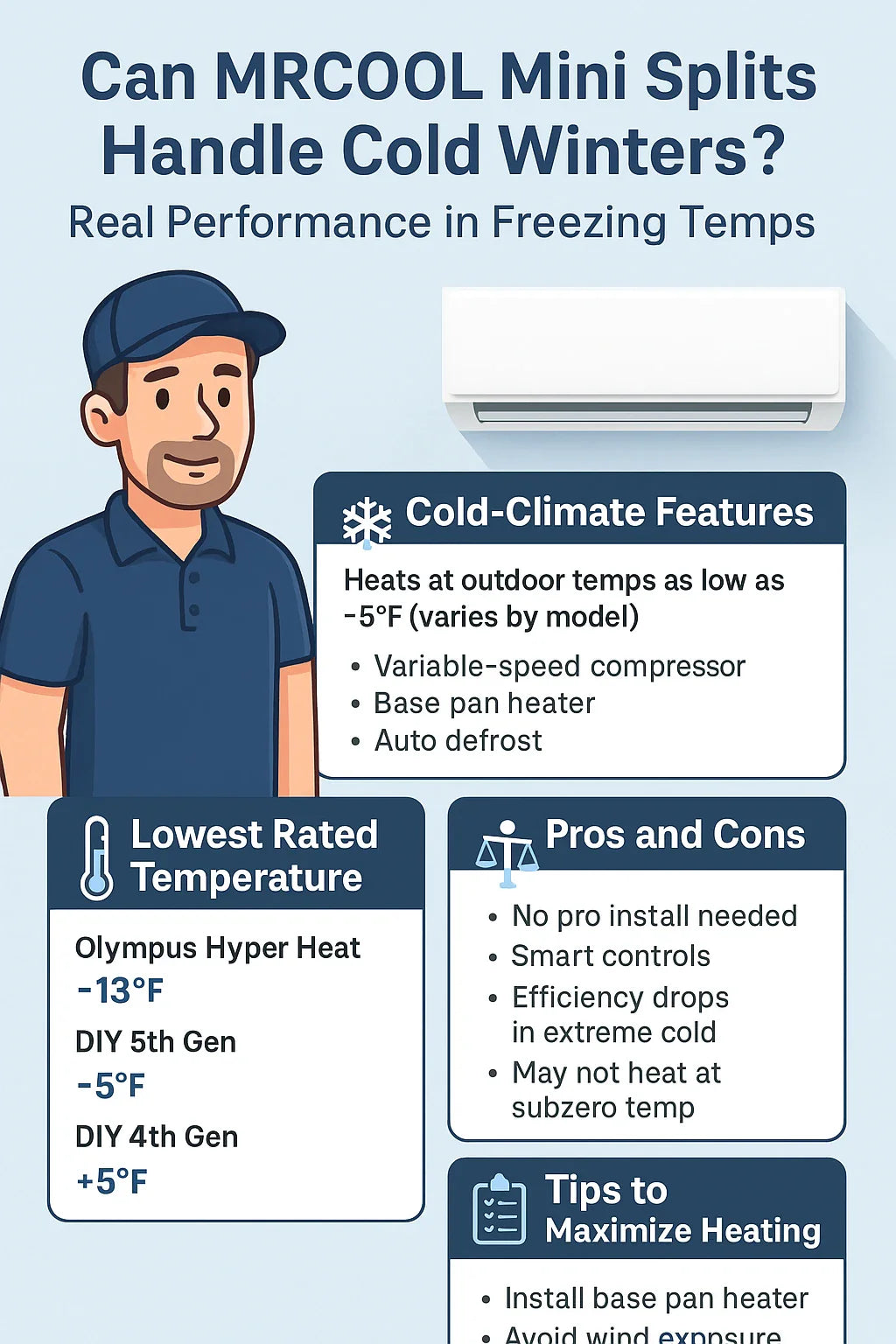🏠 Introduction: Why Cold Climate Performance Matters
When temperatures drop below freezing, not all heating systems are up to the task. If you live in a northern state or mountainous region, you’ve probably asked: “Will a ductless mini split, like MRCOOL, keep me warm through winter?” This guide answers that question with real-world insights, expert guidance, and critical specs that determine cold-weather success.
🌡️ How Do Mini Splits Work in Winter?
Mini splits, including MRCOOL systems, use a heat pump to move heat from outside air into your home—even when it’s cold. The efficiency of this process depends heavily on the ambient outdoor temperature and system design.
Modern systems like MRCOOL’s Hyper Heat and Enhanced Heating models are engineered to operate efficiently in temperatures as low as -5°F, and in some cases, -13°F.
🔁 Key Concepts:
-
COP (Coefficient of Performance): Measures heating efficiency. A higher COP means better performance.
-
HSPF2: A revised version of the Heating Seasonal Performance Factor that reflects newer efficiency standards.
-
Low Ambient Operation: Ability to extract heat from freezing outdoor air.
🔍 MRCOOL Models Designed for Cold Climates
While all MRCOOL mini splits include heating functionality, certain models are better equipped for freezing conditions:
✅ MRCOOL Olympus Hyper Heat Series
-
Operates at 100% heating capacity down to 5°F
-
Heating operation down to -13°F
-
SEER2 ratings: up to 23
-
HSPF2: up to 10.5
-
Best for: Northern U.S. homes, ski cabins, mountain regions
✅ MRCOOL DIY 4th & 5th Generation Systems
-
Rated to heat in temperatures as low as 5°F
-
New 5th Gen includes upgraded low-temp performance
-
Best for: DIYers in moderate to cold climates
✅ MRCOOL Central Ducted Hyper Heat
-
High capacity, ideal for whole-home heating
-
Heat operation down to -22°F (for certain models)
-
Best for: Larger homes or retrofitting central systems
📊 Real-World Performance Reviews
Many homeowners have shared cold-weather performance testimonials for MRCOOL mini splits:
"I live in Minnesota and the MRCOOL DIY has kept our home warm during -10°F nights without fail." — Verified Buyer, 2024
"Our Olympus Hyper Heat system outperformed our old furnace in Vermont winters. Very impressed." — Homeowner in Burlington
📹 YouTube Demonstrations:
🔧 Tips to Maximize Cold Climate Performance
Even the best mini split won’t deliver peak performance without proper setup. Here are crucial tips:
✅ Insulate Well
-
Check attic and wall insulation
-
Seal window and door drafts
✅ Mount the Outdoor Unit High
-
Avoid snow build-up or ice blocking airflow
✅ Use Auxiliary Heat if Needed
-
Space heaters or electric baseboards can supplement in extreme weather
✅ Don’t Oversize or Undersize
-
Get a proper Manual J calculation
-
Oversized systems can short-cycle; undersized may not keep up
📍 Ideal Use Cases for MRCOOL in Cold Climates
| Scenario | Recommended System |
|---|---|
| Mountain Cabins | Olympus Hyper Heat |
| Off-Grid Cabins | MRCOOL DIY 5th Gen with solar inverter |
| Northern City Homes | Central Ducted Hyper Heat |
| Garage Heating | 12k BTU DIY Wall Unit |
| Mobile Homes | MRCOOL DIY or Advantage Series |
⚖️ Pros and Cons of Using MRCOOL in Cold Winters
✅ Pros:
-
Efficient heating down to -13°F or even -22°F
-
Inverter technology = consistent heat without big swings
-
Great for zones or whole-home systems
-
Eligible for tax credits and rebates in some states
⚠️ Cons:
-
May require backup heat below -15°F (for DIY models)
-
Must be installed correctly to perform well
-
Upfront cost higher than baseboard heating
🧠 Final Verdict: Is MRCOOL Right for You This Winter?
If you live in a region that dips below freezing and want a flexible, quiet, and efficient alternative to traditional HVAC, MRCOOL has a solution. From plug-and-play DIY units to powerful Hyper Heat systems, these mini splits prove they’re no longer just for warm-weather homes.
Tip from Mike: If you’re dealing with deep winter temps, go for Hyper Heat or central ducted models—and always verify low temp performance before buying.
In the next topic we will know more about: What Size MRCOOL System Do You Need? BTU Calculations for Mike’s 3-Bedroom Home







